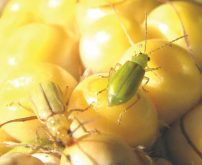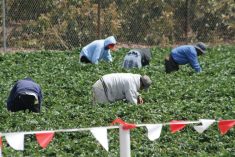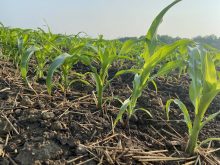Swede midge pressure may have decreased during the 2022 canola season, but new pest threats are on the horizon.
The pollen beetle, a European pest established in the Maritimes and Quebec, is creating concerns as researchers watch the Northern Ontario-Quebec border.
“It does cause significant damages to canola when the beetle larva feed inside the developing flower buds,” said Abigail Wiesner, Ontario Ministry of Agriculture, Food and Rural Affairs (OMAFRA) canola and edible bean specialist, during the Ontario Canola Growers Association annual general meeting.
Read Also

Ontario’s other economic engine: agriculture and food
Ontario Federation of Agriculture president, Drew Spoelstra, says Ontario’s agriculture and agri-food sector should be recognized for its stability and economic driving force.
Why it matters: New canola pests are emerging while producers face a claw back on effective insecticides.
A 2022 survey for pollen beetle in Temiskaming showed no pest presence, but she said continued observation and diligence are required.
“The survey will continue again in 2023 in the Temiskaming district,” Wiesner explained, asking interested participants to contact her.
Canola Flower Midge (CFM), an emerging canola gall midge threat, has prompted Ontario-based research and mapping of the pest.
CFM was first noted in Western Canada in 2016 when researchers observed a significant number of midges bypassing pheromone lures combined with a distinct canola gall injury atypical of swede midge, said Rebecca Hallett, a University of Guelph Environmental Sciences professor.
“The canola flower midge is now considered to be the predominant midge in canola in Western Canada,” said Hallett. “Swede midge may be there, but they’re not detecting it.”
In 2021 Hallett, along with colleagues Graham Ansell and Angela Gradish, began reassessing Ontario Swede midge data after their Western colleagues discovered two CFM-matched Barcode of Life Database (BOLD) Peterborough records from 2015.
CFM is morphologically and genetically distinct from swede midge; however, the lifecycle mimics the Swede midges. Adults emerge from pupae cocoons in the late spring or early summer to coincide with brassica flower buds, and females lay egg clusters on the canola flower style. The pupa then flings itself from the plant to pupate in the soil.
“They make a little cocoon out of soil and other debris and will either pupate and emerge as adults in the same season,” Hallett explained. “Or overwinter and emerge as adults the next spring.”
In 2021 research with a new CFM pheromone available experimentally revealed CFM at spring canola test sites in Dufferin, Wellington and Bruce counties and the Kawartha Lakes region. In 2022, Hallett added Chatham-Kent and Essex winter canola sites and plant sample testing identifying CFM tissue emergence and timing.
Hallett said the study confirmed CFM in two Chatham-Kent sites and Swede midge in the southwestern counties.
Early data suggests Ontario’s CFM emergence is somewhat earlier than Western Canada, occurring in early June to September with two, possibly three, emergence peaks likely representing two generations.
“A study by Megan Vankosky in Saskatoon has shown that infestation of one flower on a raceme causes a nine per cent loss of the potential yield from a raceme,” said Hallett.
“There’s quite a potential for canola flower midge to cause significant yield damage in canola.”
Hallett said more research is required to assess CFM distribution in Ontario, especially in the north, its damage symptoms, alternative host plants and susceptibility to pesticides.
“We’ve put in a (research) proposal to OMAFRA’s Agri-Food Innovation Alliance program, part of the partnership is with U of G,” said Hallett. “We’ll find out in the springtime whether it’s funded. We’ve also received some support from the OCGA for that research, so I’m very grateful.”
Hallett concluded that research differentiating Swede midge from Ontario CFM and CFM natural enemy identification would contribute to accurate and effective management recommendations.
Pest strategies
As ongoing research attempts to control emerging pests, canola producers are losing field crop access to products containing active lambda-cyhalothrin in 2023.
“These products include Matador, Silencer, Labamba, Zivata and Voliam Xpress, “said Wiesner.
“Although these products won’t be available, there’s not too much panic (because) there are alternative products available.”
Lambda-cyhalothrin controls flea beetles, cutworm, swede midge, cabbage seedpod weevil and lygus bugs.
The critical takeaway, said Wiesner, is to use a mindful approach to insecticidal control because the alternatives may include older chemistries.
“You might have to adjust the time you spray to protect pollinators or increase your cultural practices to get the best bang for your buck or pest management,” said Wiesner.
“As an entomologist, I always advocate for increased monitoring, so you’re keeping track of those high-impact pests.”
Wiesner referred to the Crop Protection Hub as a resource for guidance on insecticidal control, along with Tracey Baute, OMAFRA field crop entomologist or herself.
Wiesner encouraged winter canola growers to conduct winter survival assessments every few weeks through March and April. She said cutting open and checking for necrotic tissues forming in the stem centre could indicate poor winter survivability.
May pest monitoring should focus on flea beetle with a visual assessment for leaf and plant damage and cabbage seedpod weevil in winter canola with a sweep net from green bud through to pod formation.
Producers should employ Swede midge traps in June and scout fields for Diamondback moths and tarnished plant bugs. July heralds a return to disease monitoring for black leg and white mould scouting.
Wiesner said incorporating biosecurity practices into daily routines, like cleaning boots and equipment between fields, could eliminate or limit the spread of insects and disease.
“The reasons why we want to do this . . . is for clubroot,” said Wiesner, pointing to a map. “We can see it is spreading across Ontario, and to combat that try to incorporate biosecurity.”
She suggested producers watch Meghan Moran’s Biosecurity for crop scouts and agronomists’ video on YouTube.













